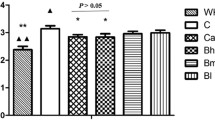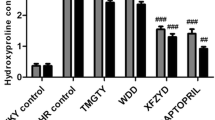Abstract
Objective
To elevate the effects of Qingxuan Jiangya Decoction (清眩降压汤, QXJYD) on hypertension and vascular structural remodeling (VSR) in spontaneously hypertensive rats (SHRs), and investigate the underlying mechanisms.
Methods
SHRs (n=8) were given intra-gastric administration with 60 mg/kg of QXJYD or saline, daily for 8 weeks, while rats in SHR-control (n=8) and WKY (n=8) groups were received equal volumes of saline solution. Systolic blood pressures (SBP), diastolic blood pressures (DBP) and mean blood pressures (MBP) were measured once a week. The levels of angiotensin II (Ang II), endothelin 1 (ET-1) and plasma renin activity (PRA) were tested by enzyme-linked immunosorbent assay (ELISA) and radioimmunoassay, respectively. The effect of QXJYD on VSR was determined by examining the media thickness and the ex vivo contractility of thoracic aortic. The proliferation and fibrosis of vascular smooth muscle cells (VSMCs) were examined via immunohistochemical (IHC) staining for proliferating cell nuclear antigen (PCNA), collagen I and collagen III, respectively. The mRNA and protein expressions of transforming growth factor β 1 (TGF-β 1), Smad3 and phosphorylation of Smad3 in thoracic aorta tissues were determined by real-time polymerase chain reaction (PCR) and Western blot assay, respectively.
Results
QXJYD treatment led to a significant decrease of the elevation of blood pressure in SHRs and reduced the levels of Ang II, ET-1 and PRA in the serum (P<0.05). In addition, QXJYD treatment remarkably ameliorated VSR and vascular function in SHRs. Moreover, QXJYD inhibited VSMC proliferation and fibrosis by suppressing the expression of PCNA, collagen I and collagen III in thoracic aortic. Furthermore, QXJYD inhibited the expression of TGF-β 1, Smad3 and the phosphorylation of Smad3, respectively (P<0.05).
Conclusion
QXJYD reversed VSR by inhibiting VSMC proliferation and collagen deposition via regulation of TGF-β 1/Smad signaling pathway, which may, in part, illuminate its anti-hypertensive activities.
Similar content being viewed by others
References
Poulter NR, Prabhakaran D, Caulfield M. Hypertension. Lancet 2015;386:801–812.
Lackland DT, Weber MA. Global burden of cardiovascular disease and stroke: hypertension at the core. Canadian J Cardiol 2015;531:569–571.
Piper MA, Evans CV, Burda BU, Margolis KL, O’Connor E, Smith N, et al. Screening for high blood pressure in adults: a systematic evidence review for the U.S. Preventive Services Task Force [Internet]. Rockville (MD): Agency for Healthcare Research and Quality (US) 2014. Available at: http://www.ncbi.nlm.nih.gov/books/NBK269495/
Lim SS, Vos T, Flaxman AD, Danaei G, Shibuya K, Adair-Rohani H, et al. A comparative risk assessment of burden of disease and injury attributable to 67 risk factors and risk factor clusters in 21 regions, 1990–2010: a systematic analysis for the Global Burden of Disease Study 2010. Lancet 2012;380:2224–2260.
Deniset JF, Hedley TE, Hlaváčková M, Chahine MN, Dibrov E, O’Hara K, et al. Heat shock protein 60 involvement in vascular smooth muscle cell proliferation. Cell Signal 2018;47:44–51.
Camargo LL, Harvey AP, Rios FJ, Tsiropoulou S, Da Silva RNO, Cao Z, et al. Vascular Nox (NADPH oxidase) compartmentalization, protein hyperoxidation, and endoplasmic reticulum stress response in hypertension. Hypertension 2018;72:235–246.
Drummond GR, Selemidis S, Griendling KK, Sobey CG. Combating oxidative stress in vascular disease: NADPH oxidases as therapeutic targets. Nat Rev Drug Discov 2011;10:453–471.
Ponticos M, Smith BD. Extracellular matrix synthesis in vascular disease: hypertension, and atherosclerosis. J Biomed Res 2014;28:25–39.
Brassard P, Amiri F, Schiffrin EL. Combined angiotensin II type 1 and type 2 receptor blockade on vascular remodeling and matrix metalloproteinases in resistance arteries. Hypertension 2005;46:598–606.
Heusch G, Libby P, Gersh B, Yellon D, Böhm M, Lopaschuk G, et al. Cardiovascular remodelling in coronary artery disease and heart failure. Lancet 2014;383:1933–1943.
Birns J, Markus H, Kalra L. Blood pressure reduction for vascular risk: is there a price to be paid? Stroke 2005;36:1308–1313.
Laurent S, Boutouyrie P. The structural factor of hypertension: large and small artery alterations. Circ Res 2015;116:1007–1021.
Renna NF, de Las Heras N, Miatello RM. Pathophysiology of vascular remodeling in hypertension. Int J Hypertens 2013;2013:808353.
Bobik A. Transforming growth factor-betas and vascular disorders. Arterioscler Thromb Vasc Biol 2006;26:1712–1720.
Gao F, Chambon P, Tellides G, Kong W, Zhang XM, Li W. Disruption of TGF-β signaling in smooth muscle cell prevents flow-induced vascular remodeling. Biochem Biophys Res Commun 2014;454:245–250.
Pacurari M, Kafoury R, Tchounwou PB, Ndebele K. The Renin-Angiotensin-aldosterone system in vascular inflammation and remodeling. Int J Inflam 2014;2014:689360.
Wrana JL, Attisano L, Cárcamo J, Zentella A, Doody J, Laiho M, et al. TGF beta signals through a heteromeric protein kinase receptor complex. Cell 1992; 71:1003–1014.
Heldin CH, Moustakas A. Role of Smads in TGF β signaling. Cell Tissue Res 2012;347:21–36.
August P, Suthanthiran M. Transforming growth factor beta signaling, vascular remodeling, and hypertension. N Engl J Med 2006;354:2721–2723.
Ten Dijke P, Arthur HM. Extracellular control of TGFbeta signalling in vascular development and disease. Nat Rev Mol Cell Biol 2007;8:857–869.
Akhurst RJ, Hata A. Targeting the TGF β signalling pathway in disease. Nat Rev Drug Discov 2012;11:790–811.
Cai GY, Zheng Y, Sun XF, Chen XM; Survey of Prevalence, Awareness, and Treatment Rates in Chronic Kidney Disease Patients with Hypertension in China Collaborative Group. Prevalence, awareness, treatment, and control of hypertension in elderly adults with chronic kidney disease: results from the survey of Prevalence, Awareness, and Treatment Rates in Chronic Kidney Disease Patients with Hypertension in China. J Am Geriatr Soc 2013;61:2160–2167.
Wang JW, Zhang LX, Wang F, Liu LS, Wang HY; China National Survey of Chronic Kidney Disease Working Group. Prevalence, awareness, treatment, and control of hypertension in China: results from a national survey. Am J Hypertens 2014;27:1355–1361.
Li YL, Nie L, Jiang HQ, Lin JM, Zhou HL, Xie J, et al. Metabonomics study of essential hypertension and its chinese medicine subtypes by using gas chromatography-mass spectrometry and nuclear magnetic resonance spectroscopy. Evid Based Complement Alternat Med 2013;2013:625906.
Yuwen Y, Han XJ, Weng WL, Zhao XY, Liu YQ, Li WQ, et al. Appraisal of the quality and contents of clinical practice guidelines for hypertension management in Chinese medicine: a systematic review. Chin J Integr Med 2018;24:545.
Chu JF. Effective cases of Qingxuan Jiangya Decoction combined with Western medicine on hypertension. J Henan Univ Chin Med (Chin) 2009;24:75–76.
Xiao F, He F, Chen HW, Lin S, Shen AL, Chen YQ, et al. Qingxuan Jiangya Decoction reverses vascular remodeling by inducing vascular smooth muscle cell apoptosis in spontaneously hypertensive rats. Molecules 2016;21:pii:E956.
Cao Y, Liu LT, Wu M. Is Chinese herbal medicine effective for elderly isolated systolic hypertension? A systematic review and meta-analysis. Chin J Integr Med 2017;23:298.
Nguyen G, Delarue F, Burcklé C, Bouzhir L, Giller T, Sraer JD. Pivotal role of the renin/prorenin receptor in angiotensin II production and cellular responses to renin. J Clin Invest 2002;109:1417–1427.
Montezano AC, Nguyen Dinh Cat A, Rios FJ, Touyz RM. Angiotensin E and vascular injury. Curr Hypertens Rep 2014;16:431.
Sharifat N, Mohammad Zadeh G, Ghaffari MA, Dayati P, Kamato D, Little PJ, et al. Endothelin-1 (ET-1) stimulates carboxy terminal Smad2 phosphorylation in vascular endothelial cells by a mechanism dependent on ET receptors and de novo protein synthesis. J Pharm Pharmacol 2017;69:66–72.
Olave N, Nicola T, Zhang W, Bulger A, James M, Oparil S, et al. Transforming growth factor-β regulates endothelin-1 signaling in the newborn mouse lung during hypoxia exposure. Am J Physiol Lung Cell Mol Physiol 2012;302:L857–L865.
Author information
Authors and Affiliations
Contributions
He F conceptualized the study. Lin S prepared the QXJYD. He F and Chen HW performed the experiments. Chu JF and Lin W performed the statistical analysis. He F and Chu JF drafted the manuscript. Chen YQ revised the manuscript. Peng J and Chen KJ finalized the manuscript. All authors read and approved the final manuscript.
Corresponding authors
Additional information
Conflict of Interest
The authors declare no financial or commercial conflict of interest.
Supported by the National Natural Science Foundation of China (No. 81774135), and the Developmental Fund of Chen Keji Integrative Medicine (No. CKJ2016004 and CKJ2017001)
Rights and permissions
About this article
Cite this article
He, F., Chu, Jf., Chen, Hw. et al. Qingxuan Jiangya Decoction (清眩降压汤) Prevents Blood Pressure Elevation and Ameliorates Vascular Structural Remodeling via Modulating TGF-β 1/Smad Pathway in Spontaneously Hypertensive Rats. Chin. J. Integr. Med. 26, 180–187 (2020). https://doi.org/10.1007/s11655-019-2705-7
Accepted:
Published:
Issue Date:
DOI: https://doi.org/10.1007/s11655-019-2705-7




